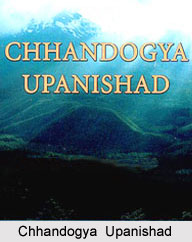 Chandogya Upanishad is one of the oldest Upanishad written during the Vedic Brahmana period about ninth to eighth century BC. Chandogya Upanishad is associated with Sama Veda. It is ranked ninth in the Muktika canon of hundred and eight Upanishadas. The first chapter of Chandogya Upanishad contains thirteen khandas.
Chandogya Upanishad is one of the oldest Upanishad written during the Vedic Brahmana period about ninth to eighth century BC. Chandogya Upanishad is associated with Sama Veda. It is ranked ninth in the Muktika canon of hundred and eight Upanishadas. The first chapter of Chandogya Upanishad contains thirteen khandas.
1st Khanda
According to the 1st Khanda the syllable Om, known as Udgitha, should be meditated upon. People singing the Udgitha, begin with Om Mantra. The earth is the essence of all these beings, the essence of the earth is water; the essence of water is plants; the essence of plants is a person; essence of a person is speech; the essence of speech is the Rig Veda; essence of the Rig Veda is the Sama Veda; the essence of the Sama Veda is the Udgitha that is Om. The Udgitha is the quintessence of all these essences; it is the Supreme. The speech is the Rig, the vital breath (prana) is the Saman; the syllable Om is the Udgitha. Speech and the prana, or the Rik and the Saman, form a couple that unites in the syllable Om. When a pair comes together they fulfil each other`s desire. Whoever realises this and meditates on the syllable Om, the Udgitha, gets his desires fulfilled.
2nd Khanda
The gods and the demons, both offspring of Prajapati once fought with each other. The gods then took hold of the Udgitha, to vanquish the demons. They thus, began meditating on the Udgitha (Om) as the prana functioning through the nose, then as speech, eye, ear, mind but the demons pierced them all with evil. However, finally when the gods meditated upon the Om on the vital breath or the principal prana the demons were immediately vanquished. Thus, whoever meditates upon the imperishable Udgitha (Om) obtains all his desires.
3rd Khanda
The 3rd Khanda states that the Udgitha (Om) must be meditated as the Sun and the Vyana. When the sun rises he sings the Udgitha for the benefit of all creatures. When the sun rises it destroys darkness and fear. One must also meditate on the Udgitha as the vyana. He who knows this becomes the destroyer of darkness and fear.
4th Khanda
The 4th Khanda states about meditation on Om as Fearlessness and Immortality. When a man masters the Rig Veda he utters the Om Mantra; he does the same when he masters the Sama Veda and the Yajur Veda. The Svara is the syllable Om that is immortal and fearless. One who understands this becomes immortal and fearless.
5th Khanda
The 5th Khanda states about meditation on Om as the Sun and the Prana. Which is the Udgitha is the Pranava; that which is the Pranava is the Udgitha. The sun is the Udgitha. It is the Pranava, because it moves along uttering Om.
6th Khanda
The 6th Khanda depicts the luminous person in the solar orb. The earth is the Rik and fire is the Saman. The Saman i.e. the fire rests on that Rik i.e. the earth. Thus, the Saman is sung resting on the Rik. Here, sa is the earth, ama is fire hence they are together called as Sama.
7th Khanda
Here the speech is the Rik and the prana is the Saman. This Saman rests on that Rik. The eye is the Rik and the Atma is the Saman. The ear is the Rik and the mind is the Saman.
8th Khanda
The 8th Khanda narrates the story of the Pravahana. Here three wise men Silaka the son of Salavat, Chaikitayana of the line of Dalbhya and Pravahana the son of Jivala well versed in the Udgitha discuss about Udgitha.
9th Khanda
The 9th Khanda is a continuation of the 8th Khanda. The wise men continue their discussion about Udgitha.
10th Khanda
The 10th Khanda narrates the story of the Ushasti. Once when the crops were destroyed Ushasti the son of Chakra along with his wife and child lived in an awful condition in the village of a man. There he thought of means of earning food.
11th Khanda
The 11th Khanda is a continuation of the 10th Khanda where Ushasti lived in a village with his wife and child after his crops were destroyed.
12th Khanda
The 12th Khanda deals with the Udgitha of the Dogs. One day, Vaka the son of Dalbhya, went to study the Vedas. On his way a white dog appeared before him. Few other dogs gathered around him asking the former dog to sing for them so that they can gather food.the white dog asked them to come the next day. The dogs kept moving with the white dog. They all sat down and uttered the syllable Him and prayed to God reciting mantras.
13th Khanda
The 13th Khanda deals with the Mystical Meaning of the Stobha Syllables. According to this the Earth is the syllable hau and the air is the syllable hai. The moon is the syllable atha; the self is the syllable iha and the fire is the syllable i.












